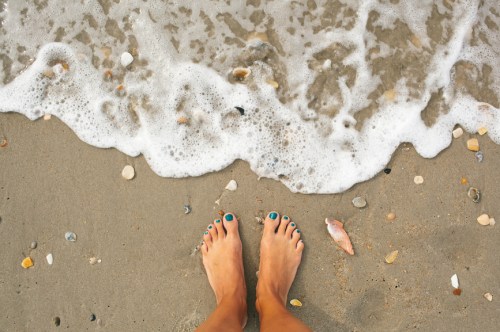The ‘Wet Foot’ Test Shows You What Type of Arches You Have—And It Takes 10 Seconds
What kind of arches do you have? Here, a podiatrist walks you through how to do the 'wet foot' test in order to find your arch type.

As its name suggests, the “wet foot” test involves wetting your feet and making an impression (aka footprint) on a piece of paper. Remember those handprint turkey paintings you made as a kid? Kind of like that but with your feet instead of your hands and water instead of paint. It’s also way less messy. The purpose of the test is to learn what type of arch you have, which is the curved area between the heel and the ball of the foot. There are three main types of arches: normal, low, and high.
Experts in This Article
board-certified podiatrist, foot surgeon, and founder of Fix Your Feet
Learning your arch type serves two main purposes. “Understanding the biomechanics of the foot can guide what type of performance shoes one should select as medical markers and leads to how a medical professional approaches which next exam to treat patients with common foot complaints directly,” says podiatrist Yolanda Ragland, DPM. In other words, it helps you select the best types of shoes for your feet and can guide needed treatment for feet-related issues.
Below, Dr. Ragland walks us through the step-by-step (sorry, I had to) on how to do the wet foot test. It takes just a few seconds. Once you do it and learn your arch type, keep scrolling to see what that says about your feet and to learn which type of shoes you should wear for ultimate support.
How to do the wet foot test
Here’s how Dr. Ragland instructs doing the wet foot test.
- 1.Fill a shallow bowl or pan with water. It must, of course, be big enough to fit your feet comfortably. You don’t need a ton of water, just enough to cover the soles of your feet.
- 2.Place an absorbent sheet of paper large enough to capture the entire impression of each foot nearby.
- 3.Immerse the soles of your feet in the water.
- 4.Step onto the center of the sheet of paper to make the impressions of each foot.
If you have normal arches…
The wet footprint of a normal arch will appear narrow in the midfoot region. “The arch impression is approximately half the width of the foot at its broadest point,” Dr. Ragland says. This indicates that the foot has an even distribution of weight throughout the foot. Lucky for you, Dr. Ragland says you can wear almost any shoe type. For performance shoes in particular, she recommends shoes with a neutral insole and modest arch support to maintain healthy foot function.
If you have high arches…
Dr. Ragland says high arches will appear approximately half the diameter of a normal arch print, or it can be absent altogether, meaning there is a thin line or gap in your footprint between the heel and the ball of the foot.
High arch feet oversupinate when walking, Dr. Ragland says. Because the arch doesn’t collapse enough to absorb the shock of walking or running, it ends up traveling up the legs and may adversely affect other joints in the body such as the ankles, knees, hips, and spine.
Dr. Ragland adds that people with high arches can also develop foot disorders such as ankle instability and hairline or stress fractures to the bones on the outside of the foot, leading to pain in the ball and heel of the foot (metatarsalgia and plantar fasciitis, respectively), bunions, hammertoes, or claw toes.
For this arch type, Dr. Ragland recommends wearing highly cushioned shoes with high arch support to protect against common foot injuries for this type. Alternatively, you can add inserts to whatever shoes you wear. “Good insoles can provide shock absorption, correct malalignment, reduce fatigue, boost athletic performance, and improve comfort and foot pain,” Dr. Ragland says.
If you have low arches…
Folks with low arches almost always have flat feet, Dr. Ragland says. So, their wet foot stamp will look twice as wide as someone with a normal arch. In other words, you’ll see almost the entire footprint on the paper. She explains that the mechanics of a low arch foot are directly associated with excessive pronation, meaning the foot’s arch collapses inward too much, making contact with the ground. Flat feet are often precursors of many foot ailments, including plantar fasciitis, bunion deformity, and hammer toes.
As for footwear, Dr. Ragland recommends sneakers with built-in cushioned arch support, a slightly raised heel, and a wide and high toe box to accommodate the broad forefoot. She also recommends seeing a podiatrist for custom orthotics or insoles for additional support.
Sign Up for Our Daily Newsletter
Get all the latest in wellness, trends, food, fitness, beauty, and more delivered right to your inbox.
Got it, you've been added to our email list.










